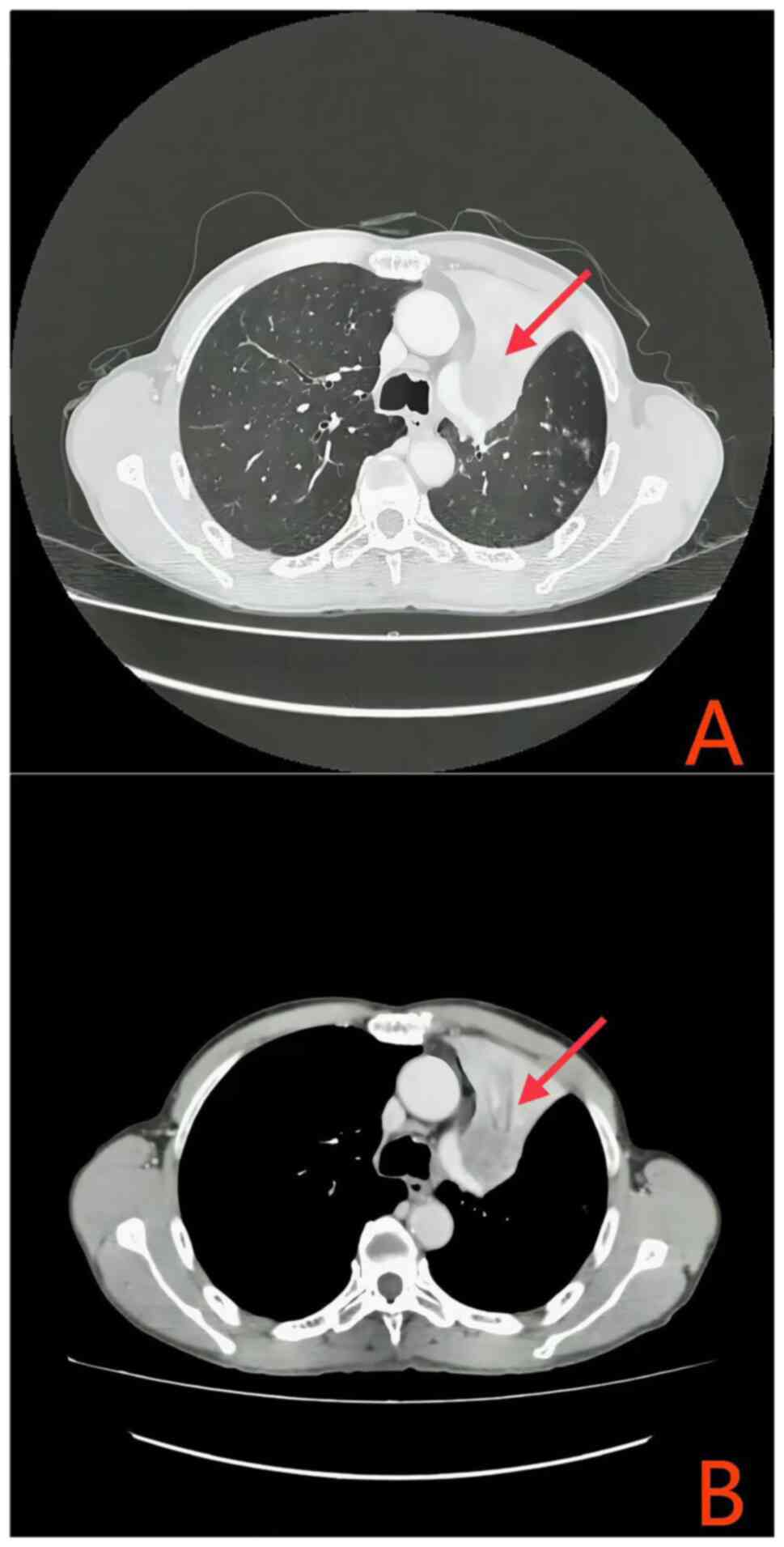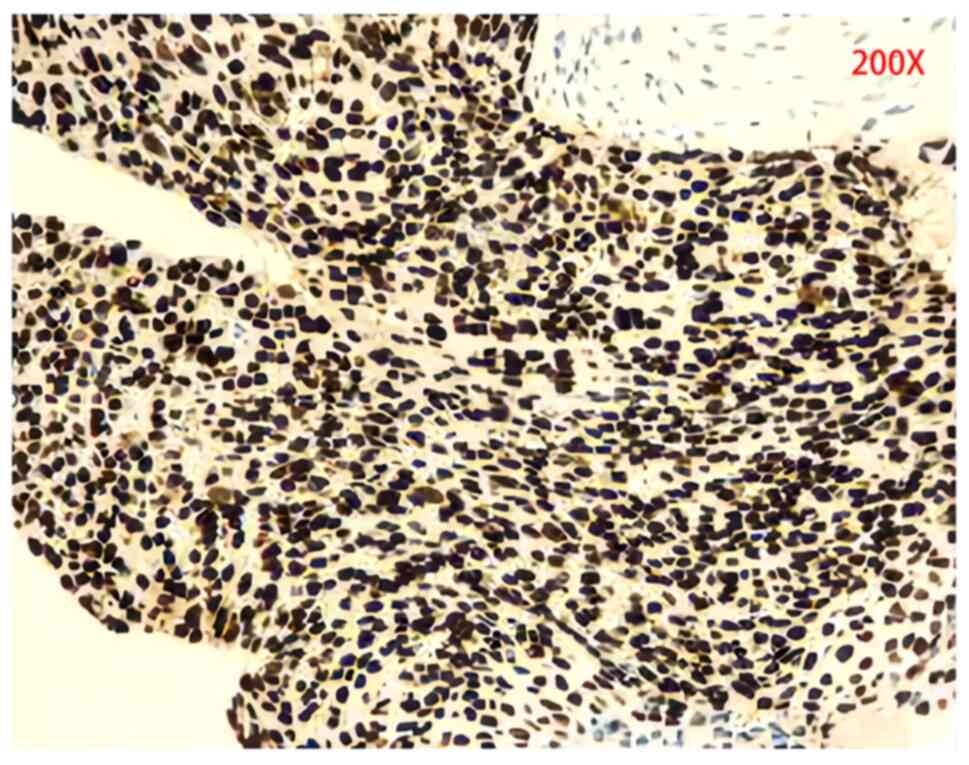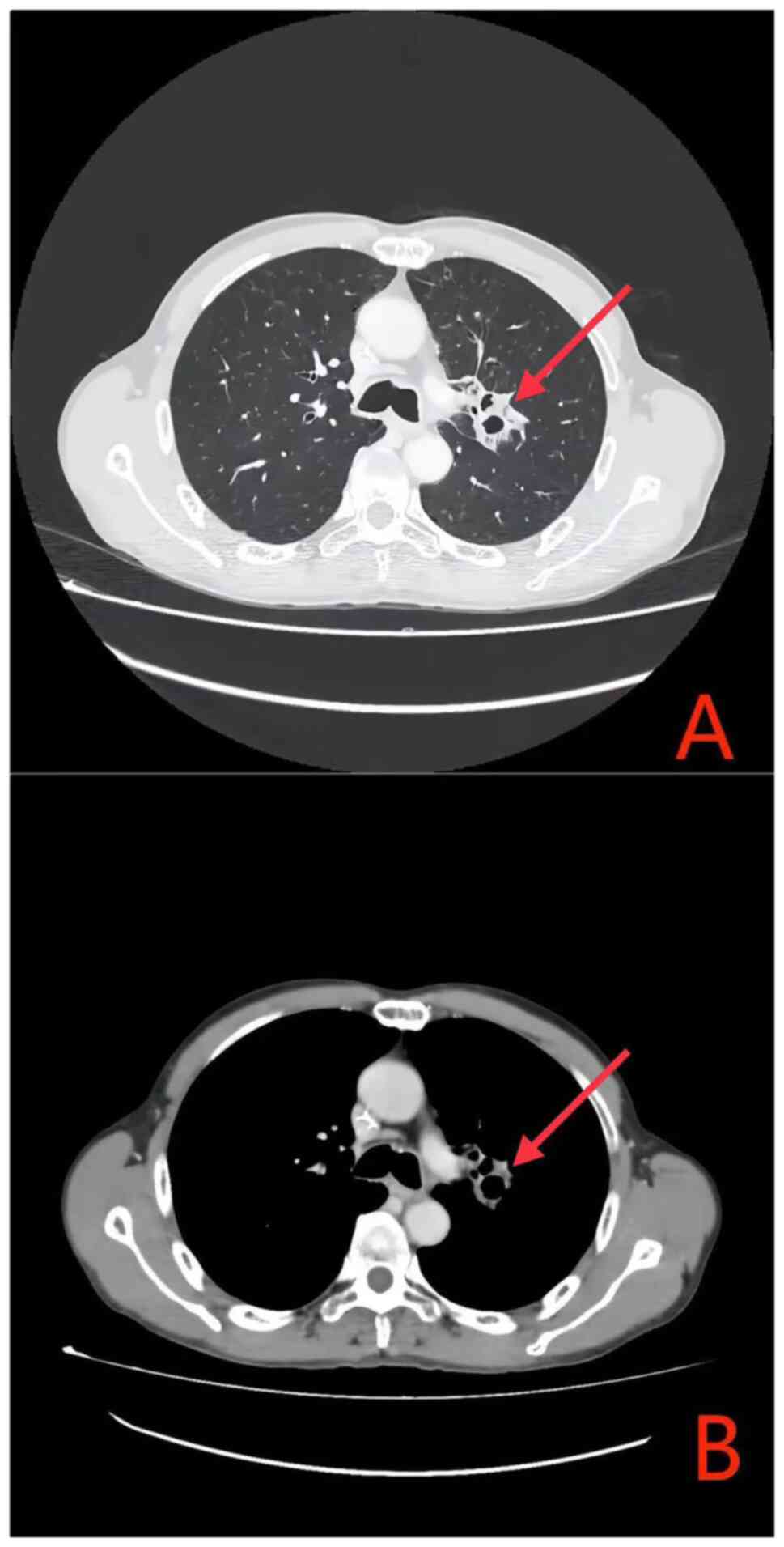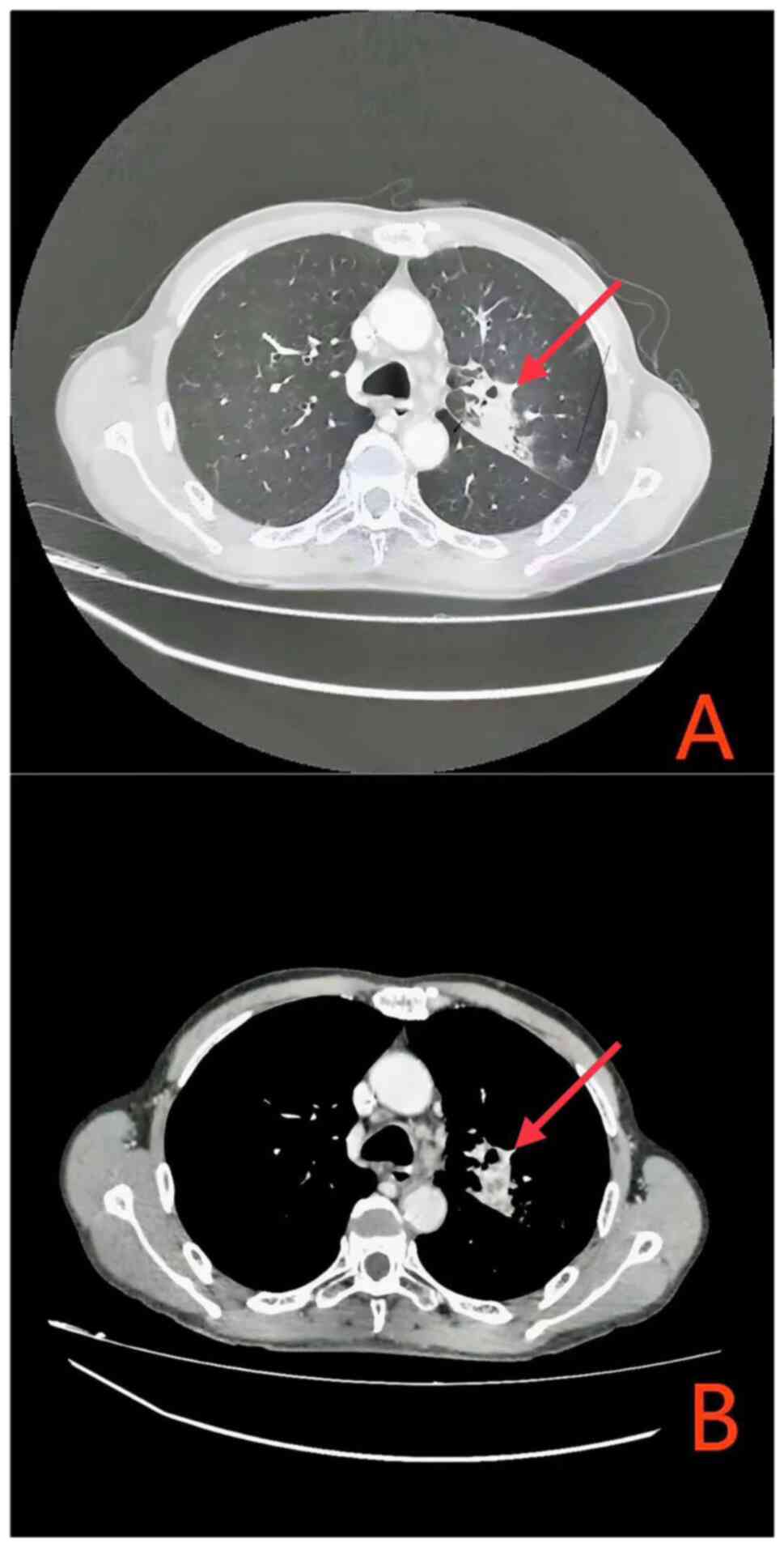Tumor lysis syndrome in a patient with advanced lung squamous cell carcinoma undergoing combined therapy with a programmed cell death protein 1 inhibitor and first‑line chemotherapy: A case report
- Authors:
- Published online on: June 17, 2024 https://doi.org/10.3892/ol.2024.14513
- Article Number: 380
-
Copyright: © Cao et al. This is an open access article distributed under the terms of Creative Commons Attribution License.
Abstract
Introduction
Lung cancer consistently demonstrates a high incidence and mortality rate worldwide, with figures standing at 12.4 and 18.7% respectively (1). Historically, the standard first-line treatment involved platinum-based doublet chemotherapy, which offers limited benefits to patients (2); however, the advent of programmed cell death protein 1 (PD-1)/programmed death-ligand 1 (PD-L1) inhibitors has substantially enhanced treatment outcomes for advanced non-small cell lung cancer, revolutionizing contemporary therapeutic strategies (3,4).
Tumor lysis syndrome (TLS) is a rare but severe complication predominantly seen in malignant lymphomas and acute lymphocytic leukemia. It is marked by profound metabolic disturbances and associated clinical symptoms, triggered by the release of cytoplasmic and nuclear components into the bloodstream due to tumor cell lysis. Manifestations include hyperkalemia, hyperuricemia, hyperphosphatemia, hypocalcemia, acute uric acid nephropathy and acute renal failure. TLS is infrequently observed in solid tumors; however, cases have been documented in small-cell lung cancer, neuroblastoma and testicular tumors (5). High tumor burden and responsiveness to treatment constitute significant risk factors for the development of TLS. Current therapeutic strategies primarily encompass intravenous hydration, stabilization of electrolyte balance, uric acid reduction, and preservation of renal function. Despite these interventions, the prognosis remains unfavorable, with a high mortality rate spanning from 29 to 79% (6,7). To date, no cases of TLS have been reported in patients with lung squamous cell carcinoma (SCC) treated with PD-1/PD-L1 inhibitors combined with chemotherapy, to the best of our knowledge.
The present study reports a novel case of TLS in a patient with advanced lung SCC following first-line treatment with a PD-1 inhibitor and chemotherapy. The present case underscores the critical need for increased vigilance, enhanced early detection, and prompt intervention to manage the rare occurrence of TLS in this patient population.
Case report
A 61-year-old male patient presented to the Second People's Hospital of Guiyang, (Guiyang City, Guizhou Province, in July 2023, exhibiting a persistent cough accompanied by hemoptysis for a duration exceeding two months. Enhanced chest computed tomography (CT) revealed a suspected left upper lobe lung cancer with obstructive pneumonia (Fig. 1A). Further CT imaging delineated atelectasis in the left upper lobe, the primary lung lesion measuring only 36 mm in diameter, multiple pulmonary nodules indicative of metastatic disease, and enlarged mediastinal lymph nodes (Fig. 1B); however, cranial magnetic resonance imaging, enhanced upper abdominal CT and whole-body bone imaging showed no significant abnormalities. Bronchoscopic pathological biopsy was performed and the pathological analysis of the tissue specimens demonstrated the presence of squamous cell carcinoma of the lung (For routine tissue staining, we utilize Hematoxylin and Eosin (HE) staining. Specifically, tissues are fixed in 10% formalin at room temperature for 6 h, and the slices are cut to a thickness of 3 µm. The staining protocol proceeds as follows: three xylene baths, each lasting 3 min; two baths of absolute ethanol, each for 3 min; a single bath of 95% alcohol for 2 min; two hematoxylin baths, each for 5 min; a brief 3-sec exposure to hydrochloric acid-alcohol; a 1-min treatment with lithium carbonate; eosin staining for 30 sec; and rinsing through a series of alcohol baths with varying concentrations (75% for 10 sec, 85% for 10 sec, 90% for 10 sec, and 95% for 1 min), followed by two baths of absolute ethanol, each lasting 2 min. Microscopic examination is performed using a LEICA2000 microscope. For immunostaining, paraffin-embedded tissues are fixed in 10% formalin at room temperature for 6 h. No resin treatment is employed, and the slice thickness remains at 3 um. No permeabilization reagents are used. Antigen retrieval and exposure for paraffin-embedded tissues are primarily achieved through high pressure and high-temperature treatment with EDTA repair solution, facilitating superior binding of antibodies to their respective antigens. A 3% H2O2 blocking reagent is applied for 15 min at room temperature, and no serum blocking is utilized. The primary antibodies and their respective dilutions, catalog numbers, and suppliers are: CK 1:300, CgA 1:200, Vimentin 1:400, EMA 1:200, Ki-67 1:200, P53 1:200, CK5/6 1:250, P40 1:200, P63 1:200, TTF-1 1:200, Napsin-A 1:150, Desmin 1:100, S-100 1:200, CD56 1:150, Syn 1:200. All antibodies are provided by Wuxi OriGene Biotechnology Co., Ltd. and incubated at 37°C for 1 h. The secondary antibodies are prepared as working solutions, with the catalog number specified as HRP (horseradish peroxidase). The supplier is Venta Medical Group, and the incubation conditions. The secondary antibody is diluted to a working solution, with the catalog number specified as HRP (horseradish peroxidase). The supplier is Venta Medical Group, and the incubation conditions are 37°C for 30 min. DAB is used, with the detection reagent named as DAB Chromogenic Solution. The type of microscope used is a LEICA2000 microscope), devoid of any indicia of small cell components (Fig. 2). This observation unequivocally precluded the possibility of small cell carcinoma in the differential diagnostic considerations. The laboratory evaluation pertaining to liver and kidney functionality, electrolytes and lymphocyte subsets are outlined in Tables I and II. Upon performing a thorough assessment of the driver genes of the patient, no clinically significant genetic mutations were identified. PD-L1 tumor proportion score of the patient was noted to be <1%. The patient was diagnosed with SCC of the left upper lung, obstructive pneumonia and atelectasis, with invasion into the left main bronchus, mediastinum and major blood vessels. Lymph node metastases were confirmed in regions 1R/L, 2R, 3A, 4R/A, 5, 6, 7 and 10R/L, with multiple pulmonary metastases. The disease was staged as cT4N3M1a IVA according to the International Association for the Study of Lung Cancer staging system 9th Edition (8), with PD-L1 expression <1%.
In July 2023, the patient began treatment with a combination of albumin-bound paclitaxel, cisplatin and a PD-1 inhibitor. Tislelizumab 200 mg was administered via intravenous drip on Day 1. Paclitaxel (albumin-bound) 395 mg was administered via intravenous drip on Day 2. Cisplatin 110 mg was administered via intravenous drip from Day 2 to Day 3, divided into two administrations. The treatment cycle is 21 days, and this is the first cycle. Subsequently, in August 2023, a comprehensive re-evaluation of the hepatic and renal function of the patient, along with electrolyte profiling, revealed hyperkalemia, hyperphosphatemia, hyperuricemia, hypocalcemia and signs of acute renal impairment (Table I); however, the patient remained asymptomatic for arrhythmia, tetany, muscular spasms, hypotension, nausea, vomiting, abdominal discomfort or oliguria. Based on consensus guidelines from the TLS expert panel (9), a diagnosis of laboratory-confirmed TLS was considered. Treatment included rectal administration of Shenkang Shuan (4 g (4× daily), oral Niuduqing granules 5 g for kidney protection (3× daily) Until renal function returns to normal, oral cyclosilicate sodium powder to reduce potassium levels (3× times daily, adjusted to 5 g orally 3× daily to maintain stability once the blood potassium levels normalized), and febuxostat 20 mg (once daily) to decrease uric acid levels. Fluid replacement and dynamic monitoring of liver, kidney and heart function were initiated, along with symptomatic treatment [Administer intravenous infusion of 0.9% sodium chloride injection at a dosage of 3 l/m2 daily, and maintain urine output at a rate greater than 100 ml/(m2•h)]. After fluid replacement, urine alkalinization, electrolyte correction and kidney protection, the parameters of the patient improved (Table I). In accordance with the monitoring recommendations outlined in the National Comprehensive Cancer Network® guidelines during initial therapy (10), due to the manifestation of TLS symptoms in the patient, a timely assessment of any changes in the condition of the patient was imperative. Therefore, following a single cycle of chemotherapy combined with PD-1 immunotherapy, radiological reassessment performed at 4 weeks post-treatment demonstrated a marked decrease in the size of both the primary lung lesion and the metastatic lymph nodes when compared with the baseline prior to treatment (Fig. 3). The treatment efficacy was classified as a partial response (PR) based on the Response Evaluation Criteria in Solid Tumours (RECIST) 1.1 criteria (11) (Figs. 2 and 3). From the second cycle onwards, the chemotherapy drug was adjusted to albumin-bound paclitaxel + carboplatin (Tislelizumab 200 mg was administered via intravenous drip on Day 1. Paclitaxel (albumin-bound) 395 mg was administered via intravenous drip on Day 2. Carboplatin 440 mg was administered via intravenous drip on Day 2. The treatment cycle is 21 days). Upon completion of the systematic treatment, the efficacy evaluation according to RECIST 1.1 criteria was classified as a PR (Fig. 4). As of April 2024, the patient's condition remains stable.
Discussion
Non-small cell lung cancer accounts for ~80% of lung cancer cases, with lung squamous cell carcinoma (SCC) identified as a subtype linked to a poor prognosis. Recent advancements in immune checkpoint blockade therapy have notably improved the prognosis for patients with advanced lung SCC, PD-1 inhibitors plus chemotherapy showed a clinically meaningful improvement in OS (HR, 0.71;95% CI, 0.58 to 0.88) and PFS (HR, 0.57; 95% CI, 0.47 to 0.69) vs. placebo plus chemotherapy in the protocol-specified (11,12). PD-1 inhibitors, which are IgG4 antibodies, target the PD-1 receptors on T cells, disrupting the immune evasion mechanism of the tumor and preserving the tumoricidal activity of these cells (13).
TLS is an oncologic emergency that, whilst rare in solid tumors, has been observed in drug-sensitive malignancies such as small-cell lung cancer, neuroblastoma and testicular tumors (5). TLS results from extensive necrosis of tumor cells, leading to intracellular changes, increased membrane permeability and the release of necrotic contents into the bloodstream. This causes metabolic disturbances such as hyperkalemia, hyperuricemia, hyperphosphatemia, hypocalcemia and acute renal failure. A significant tumor burden is considered a high-risk factor for TLS development. In the present case, despite the primary lung lesion measuring only 36 mm in diameter, the patient had multiple metastatic lymph nodes across several areas (1R/L, 2R, 3A, 4R/L, 5, 6, 7 and 10R/L), contributing to a substantial overall tumor burden. Notably, the PD-L1 tumor proportion score of the patient was noted to be <1%.
Immunohistochemical analysis of PD-L1 expression is the first clinically validated biomarker predictive of response to immune therapy, with higher expression levels generally associated with improved outcomes (14). Nevertheless, patients with low PD-L1 expression can still benefit from PD-1/PD-L1 inhibitors (15), highlighting the need for additional biomarkers to guide immunotherapy in distinct patient subgroups. Studies have assessed the relationship between peripheral blood lymphocytes and immunotherapy outcomes (16–18). In the present patient, cytotoxic T cells (CD3+CD8+CD28+) accounted for 56.4% of the peripheral lymphocyte subset, notably above the normal reference values. After one cycle of administration of a PD-1 inhibitor combined with chemotherapy, the patient achieved a PR. Evidence suggests that high levels of circulating CD8+ T cells are associated with improved clinical outcomes in patients receiving PD-1 inhibitors (18–20), indicating that monitoring lymphocyte subsets could be a valuable strategy for identifying high-risk patients. Furthermore, management of TLS involves active hydration to optimize renal perfusion and glomerular filtration rate, reduce deposition of uric acid and calcium phosphate in the renal tubules, and enhance uric acid solubility and excretion. In cases of refractory electrolyte disturbances, fluid overload or rapid renal function decline, dialysis should be initiated promptly.
In conclusion, the widespread use of PD-1 inhibitors necessitates vigilant monitoring for TLS in solid tumors. Prompt intervention, dynamic post-treatment monitoring and early TLS detection are crucial for improving patient compliance, ensuring treatment continuity and optimizing outcomes.
Acknowledgements
Not applicable.
Funding
Funding: No funding was received.
Availability of data and materials
The data generated in the present study may be requested from the corresponding author.
Authors' contributions
LC contributed to the conceptualization, design, analysis, and writing of the original and subsequent drafts. WC contributed to data collection, advised on patient treatment, interpretation of data, and reviewed and edited the manuscript. LC and WC confirm the authenticity of all the raw data. Both authors have read and approved the final manuscript.
Ethics approval and consent to participate
Not applicable.
Patient consent for publication
The patient gave written informed consent for the publication of patient data and associated images.
Competing interests
The authors declare that they have no competing interests.
References
|
Bray F, Laversanne M, Sung H, Ferlay J, Siegel RL, Soerjomataram I and Jemal A: Global cancer statistics 2022: GLOBOCAN estimates of incidence and mortality worldwide for 36 cancers in 185 countries. CA Cancer J Clin. 74:229–263. 2024. View Article : Google Scholar : PubMed/NCBI | |
|
Morgensztern D, Waqar S, Subramanian J, Gao F and Govindan R: Improving survival for stage IV non-small cell lung cancer: A surveillance, epidemiology, and end results survey from 1990 to 2005. J Thorac Oncol. 4:1524–1529. 2009. View Article : Google Scholar : PubMed/NCBI | |
|
Gadgeel S, Rodríguez-Abreu D, Speranza G, Esteban E, Felip E, Dómine M, Hui R, Hochmair MJ, Clingan P, Powell SF, et al: Updated Analysis From KEYNOTE-189: Pembrolizumab or placebo plus pemetrexed and platinum for previously untreated metastatic nonsquamous non-small-cell lung cancer. J Clin Oncol. 38:1505–1517. 2020. View Article : Google Scholar : PubMed/NCBI | |
|
Novello S, Kowalski DM, Luft A, Gümüş M, Vicente D, Mazières J, Rodríguez-Cid J, Tafreshi A, Cheng Y, Lee KH, et al: Pembrolizumab Plus Chemotherapy in Squamous Non-Small-Cell Lung Cancer: 5-Year Update of the Phase III KEYNOTE-407 Study. J Clin Oncol. 41:1999–2006. 2023. View Article : Google Scholar : PubMed/NCBI | |
|
Howard SC, Jones DP and Pui CH: The tumor lysis syndrome. N Engl J Med. 364:1844–1854. 2011. View Article : Google Scholar : PubMed/NCBI | |
|
Klemencic S and Perkins J: Diagnosis and management of oncologic emergencies. West J Emerg Med. 20:316–322. 2019. View Article : Google Scholar : PubMed/NCBI | |
|
Papapanou M, Athanasopoulos AE, Georgiadi E, Maragkos SA, Liontos M, Ziogas DC, Damaskos D and Schizas D: Spontaneous tumor lysis syndrome in patients with solid tumors: A scoping review of the literature. Med Oncol. 40:2332023. View Article : Google Scholar : PubMed/NCBI | |
|
Asamura H, Nishimura KK, Giroux DJ, Chansky K, Hoering A, Rusch V and Rami-Porta R; Members of the IASLC Staging and Prognostic Factors Committee and of the Advisory Boards, and Participating Institutions, : IASLC lung cancer staging project: The New Database to Inform Revisions in the Ninth Edition of the TNM classification of lung cancer. J Thorac Oncol. 18:564–575. 2023. View Article : Google Scholar : PubMed/NCBI | |
|
Perissinotti AJ, Bishop MR, Bubalo J, Geyer MB, Goodrich A, Howard SC, Kula J, Mandayam S, Cairo MS and Pui CH: Expert consensus guidelines for the prophylaxis and management of tumor lysis syndrome in the United States: Results of a modified Delphi panel. Cancer Treat Rev. 120:1026032023. View Article : Google Scholar : PubMed/NCBI | |
|
Ettinger DS, Wood DE, Aisner DL, Akerley W, Bauman JR, Bharat A, Bruno DS, Chang JY, Chirieac LR, DeCamp M, et al: NCCN Guidelines® Insights: Non-Small Cell Lung Cancer, Version 2.2023. J Natl Compr Canc Netw. 21:340–350. 2023. View Article : Google Scholar : PubMed/NCBI | |
|
Schwartz LH, Litière S, de Vries E, Ford R, Gwyther S, Mandrekar S, Shankar L, Bogaerts J, Chen A, Dancey J, et al: RECIST 1.1-Update and clarification: From the RECIST committee. Eur J Cancer. 62:132–137. 2016. View Article : Google Scholar : PubMed/NCBI | |
|
Zhong H, Sun S, Chen J, Wang Z, Zhao Y, Zhang G, Chen G, Zhou M, Zhou J, Du Y, et al: First-line penpulimab combined with paclitaxel and carboplatin for metastatic squamous non-small-cell lung cancer in China (AK105-302): A multicentre, randomised, double-blind, placebo-controlled phase 3 clinical trial. Lancet Respir Med. 12:355–365. 2024. View Article : Google Scholar : PubMed/NCBI | |
|
Lee SH, Lee HT, Lim H, Kim Y, Park UB and Heo YS: Crystal structure of PD-1 in complex with an antibody-drug tislelizumab used in tumor immune checkpoint therapy. Biochem Biophys Res Commun. 527:226–2312. 2020. View Article : Google Scholar : PubMed/NCBI | |
|
Reck M, Rodríguez-Abreu D, Robinson AG, Hui R, Csőszi T, Fülöp A, Gottfried M, Peled N, Tafreshi A, Cuffe S, et al: Updated Analysis of KEYNOTE-024: Pembrolizumab versus platinum-based chemotherapy for advanced non-small-cell lung cancer With PD-L1 tumor proportion score of 50% or Greater. J Clin Oncol. 37:537–546. 2019. View Article : Google Scholar : PubMed/NCBI | |
|
Man J, Millican J, Mulvey A, Gebski V and Hui R: Response rate and survival at key timepoints with PD-1 blockade vs chemotherapy in PD-L1 Subgroups: Meta-Analysis of Metastatic NSCLC Trials. JNCI Cancer Spectr. 5:pkab0122021. View Article : Google Scholar : PubMed/NCBI | |
|
Gridelli C, Ardizzoni A, Barberis M, Cappuzzo F, Casaluce F, Danesi R, Troncone G and De Marinis F: Predictive biomarkers of immunotherapy for non-small cell lung cancer: Results from an Experts Panel Meeting of the Italian Association of Thoracic Oncology. Transl Lung Cancer Res. 6:373–386. 2017. View Article : Google Scholar : PubMed/NCBI | |
|
Gascón M, Isla D, Cruellas M, Gálvez EM, Lastra R, Ocáriz M, Paño JR, Ramírez A, Sesma A, Torres-Ramón I, et al: Intratumoral versus circulating lymphoid cells as predictive biomarkers in lung cancer patients treated with immune checkpoint inhibitors: Is the Easiest Path the Best One? Cells. 9:15252020. View Article : Google Scholar : PubMed/NCBI | |
|
Kim KH, Kim CG and Shin EC: Peripheral blood immune cell-based biomarkers in anti-PD-1/PD-L1 therapy. Immune Netw. 20:e82020. View Article : Google Scholar : PubMed/NCBI | |
|
Geng R, Tang H, You T, Xu X, Li S, Li Z, Liu Y, Qiu W, Zhou N, Li N, et al: Peripheral CD8+CD28+ T lymphocytes predict the efficacy and safety of PD-1/PD-L1 inhibitors in cancer patients. Front Immunol. 14:11258762023. View Article : Google Scholar : PubMed/NCBI | |
|
Hong JY, Cho HJ, Sa JK, Liu X, Ha SY, Lee T, Kim H, Kang W, Sinn DH, Gwak GY, et al: Hepatocellular carcinoma patients with high circulating cytotoxic T cells and intra-tumoral immune signature benefit from pembrolizumab: Results from a single-arm phase 2 trial. Genome Med. 14:12022. View Article : Google Scholar : PubMed/NCBI |













